Abstract
In the contemporary era, due to the women’s ascension to management positions more and more often, studying their representation in various organizations has become a point of interest for many authors. Although statistics in recent years have identified an upward trend in the presence of women in leadership positions, it seems that this is true only for middle-level management, while for senior management positions women still have a very small percentage. These percentages are due to the existing stereotypes according to which women have poor professional training and also greater family responsibility than men. The woman’s path to senior management positions is presented in publications as paved with “glass shavings”. When it comes to women in top management positions, studies abound in concepts involving this element, such as: glass ceiling, glass escalator, glass cliff. The most popular concept is the “glass ceiling”, which signifies the possibility of women’s ascension to management positions only to a certain point. In addition, it is still considered that management activities are traditionally masculine, while women are assigned household and childcare activities. The aim of this paper is to approach women’s representation in management positions and the level of management where they are active, in 10 national sports federations from Romania. In the 10 national sports federations surveyed, women had a representation of 20% for the position of president, 18% for vice-president, 20% for general secretary and 30% for federal coach.
Keywords: Woman managersports managementgender equality
Introduction
Although women’s involvement in sports field is growing, they are still under-represented in decision-making positions in sports structures, both at the local, national, European and global levels. At European level, women occupy an average of 14% of the decision-making positions in the continental confederations of Olympic sports, according to the report of the European Institute for Gender Equality (EIGE, 2017). Also, in the 28 confederations analysed, of the 91 management positions, there were only one female president and eight vice-presidents. Therefore, as we move forward in the institutional hierarchy, gender disparities are increasing.
In addition, in our country it is still widely considered that management activities are traditionally masculine, while women are assigned household and childcare activities (The Gallup Organization, 2000) and women are viewed as a vulnerable group on the labour market (Cornea & Petreuș, 2012).
Problem Statement
This paper addresses the issue of gender equality in national sports federations, more precisely the representation of women in the top management positions of these sports structures.
At the level of the EU Member States, the representation of women in the highest decision-making positions in sports organizations remains extremely low. In 2015, on average, only 14% of these posts were occupied by women, ranging from 3% (in Poland) to 43% (in Sweden).
For the position of president, women accounted for only 4% in 2015, 9% for vice-president, 15% for member of the highest commissions, and 22% for general manager/ general secretary (Figure
These percentages illustrate that although women have begun to be represented in management positions in sports organizations, the more we get into the hierarchy of top management, the percentage of women’s representation is decreasing (Shaw & Frisby, 2006). This concept is known as the “glass ceiling”, which signifies the possibility of women’s ascension to management positions only to a certain point (Avram & Cooper, 2008). We can see how, from 22% for the positions of general secretary, we only reach 4% for the position of president.
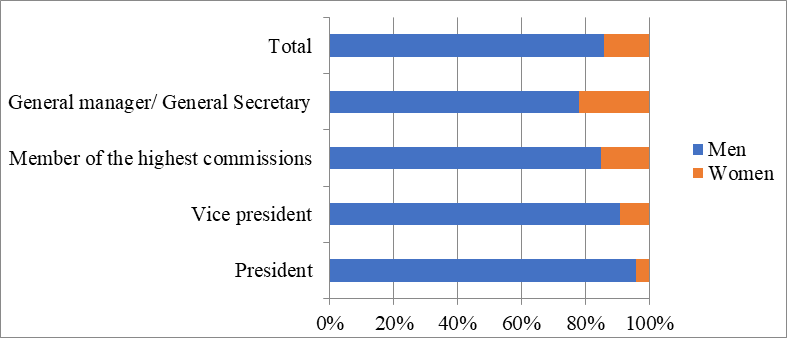
Research Questions
In the present paper we wanted to answer such questions as: “Are women equally represented in management positions in national sports federations?”, “Are women represented in a higher percentage in low and middle management positions than in top management positions?”
Purpose of the Study
The purpose of this study was to identify the current state of women’s representation in management positions in 10 national sports federations.
Research Methods
In the study, we used the following research methods to collect the necessary data: literature review and unstructured interview. For the processing of the obtained data we used the statistical-mathematical method, and for the suggestive representation of the obtained results we later used the graphic representation method.
The study was conducted on 10 national sports federations, analyzing the representation of women in management positions, more specifically, the president, vice-president, general secretary and federal coach positions from these federations.
Findings
To carry out our study, we chose 10 national sports federations, namely: Romanian Swimming and Modern Pentathlon Federation, Romanian Handball Federation, Romanian Basketball Federation, Romanian Athletics Federation, Romanian Triathlon Federation, Romanian Rugby Federation, Romanian Rhythmic Gymnastics Federation, Romanian Judo Federation, Romanian Table Tennis Federation, Romanian Baseball and Softball Federation. We chose these federations for their diversity: we have team sports federations and individual sports federations, more developed federations and smaller federations, well-known national federations with notable results, and less known federations.
In Table
Only two of the 10 national sports federations have female presidents, respectively: Romanian Swimming and Modern Pentathlon Federation and Romanian Rhythmic Gymnastics Federation. Thus, women are represented by 20% in the most important position of a federation (Figure
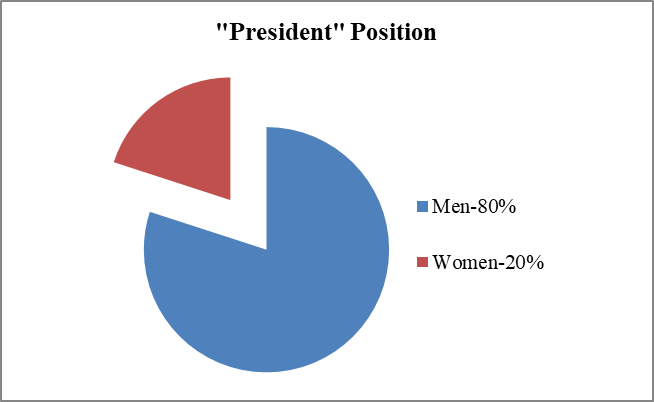
For the vice-president position, the percentage is even lower, 18% (Figure
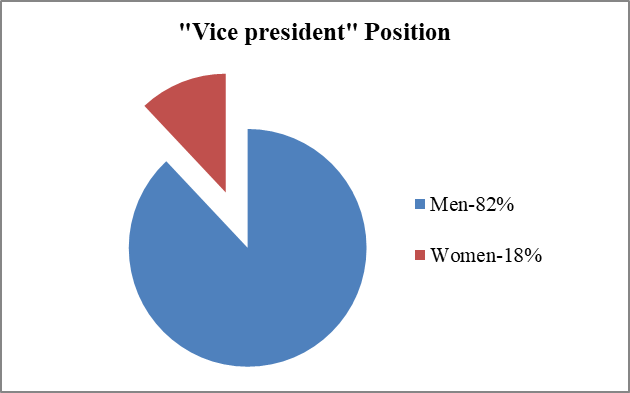
For the position of general secretary, we have only two women (Romanian Rhythmic Gymnastics Federation and Romanian Table Tennis Federation), respectively a percentage of 20, the same as in the case of the president position (Figure
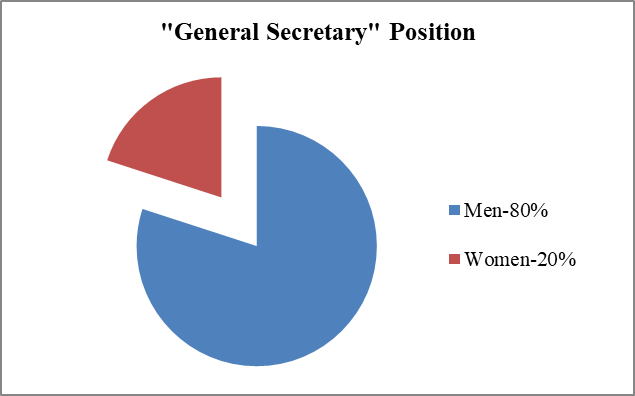
In the 10 federations we have 20 federal coaches, of which 6 are women, respectively 30% (Figure
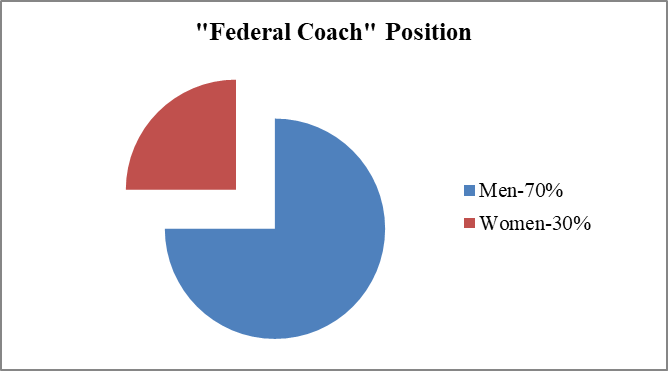
Conclusion
The main conclusion from this study is that women are not equally represented in management positions in national sports federations. In the 10 national sports federations surveyed, women had a representation of 20% for the position of president, 18% for vice-president, 20% for general secretary and 30% for federal coach. Therefore, women have a higher percentage of representation in low and middle management than in top management positions. The same situation can be observed in the percentage of women occupying decision-making positions in the continental confederations of Olympic sports in Europe where, from 22% for the positions of general secretary, we only reach 4% for the position of president.
We also identified a single federation where all 4 management positions are occupied by women, Romanian Rhythmic Gymnastics Federation (rhythmic gymnastics being a sport practiced only by women in our country). In 3 of the 10 federations, women are not present in any of the 4 management positions: Romanian Triathlon Federation, Romanian Rugby Federation and Romanian Baseball and Softball Federation.
Analysing all this data, we can say that women are still under-represented in management positions in national sports federations and the situation may not change in the near future. A solution for increasing gender-balanced representation could be to impose gender quotas in these national structures, as it is already happening in various sports organizations at European level and not only (European Commission, 2013).
References
- Avram, E., & Cooper, C. (2008). Psihologie organizațional-managerială, Tendințe actuale. Iași: Polirom.
- Cornea, A., & Petreuș, I. (2012). Ghid privind egalitatea de șanse și de gen în România. Retrieved from https://sprijincopiidefavorizati.files.wordpress.com/2016/04/ghidul-anti-discriminare.pdf
- European Commission. (2013).Gender Equality in Sport. Proposal for Strategic Actions 2014-2020. Retrieved from http://ec.europa.eu/assets/eac/sport/events/2013/documents/20131203-gender/final-proposal-1802_en.pdf
- European Institute for Gender Equality (EIGE). (2017). Gender Equality Index 2017: Measuring gender equality in the European Union 2005-2015 – Report. Retrieved from https://eige.europa.eu/rdc/eige-publications/gender-equality-index-2017-measuring-gender-equality-european-union-2005-2015-report
- Shaw, S., & Frisby, W. (2006). Can gender equity be more equitable?: Promoting an alternative frame for sport management research, education and practice. Journal of Sport Management, 20(4), 483-509.
- The Gallup Organization, Romania. (2000). Barometrul de gen: România August 2000. Bucharest: Fundația pentru o Societate Deschisă.
Copyright information

This work is licensed under a Creative Commons Attribution-NonCommercial-NoDerivatives 4.0 International License.
About this article
Publication Date
16 February 2019
Article Doi
eBook ISBN
978-1-80296-054-9
Publisher
Future Academy
Volume
55
Print ISBN (optional)
-
Edition Number
1st Edition
Pages
1-752
Subjects
Sports, sport science, physical education
Cite this article as:
Albu, S., & Fediuc, A. (2019). Women’s Representation In Management Positions In Ten Romanian Sports Federations. In V. Grigore, M. Stănescu, M. Stoicescu, & L. Popescu (Eds.), Education and Sports Science in the 21st Century, vol 55. European Proceedings of Social and Behavioural Sciences (pp. 432-437). Future Academy. https://doi.org/10.15405/epsbs.2019.02.54
